The Founder’s Cheat Sheet: Smarter, Faster SEO with AI (That Actually Works)
Founder OS: A practical, research-backed plan to protect (and grow) organic traffic when AI summaries sit above your links.
Fewer Pages, More Proof
A founder once spent six months and $30,000 building a massive blog archive. Every week, they published four long-form posts optimized for long-tail keywords. Rankings went up. So did impressions. But leads went flat and trial signups barely moved.
The kicker was when they searched their own core queries, Google’s AI summary answered everything before their site even showed up.
And it’s not just one example. This is the exact spot where a lot of startups find themselves now; burning time and money chasing rankings in a world where clicks are drying up and summaries are doing the talking.
But what if you flipped the narrative?
What if you didn’t actually need more content? What if instead, what you need is fewer, better pages; the kind that AI models want to cite and not just rank.
That means pages with original proof. Pages that show instead of tell. Pages built around specific search intents, not vague head terms. And pages structured in ways that give generative engines something worth quoting.
In this guide, we’ll walk through a simple 14-day sprint to identify what to keep, what to cut, and what to build. You’ll get measurement setups, risk guardrails, and tactics that actually work for small teams. No fluff. No 80-page content calendars. Just a smarter way to win traffic when AI owns the first impression.
Let’s reset your SEO.
Table of Contents
1. Everything You Need To Know About SEO in 2025
2. What Success Looks Like for a Founder
3. The Founder Advantage: Why Lean Teams Can Dominate
4. Start with Measurements You’ll Use (Set Up Once, Reuse Forever)
5. A 30/60/90 Plan (Founder Timeboxed)
6. When (and When Not) to Use AI in Your SEO Workflow
7. The One-Page Checklist (End on Action)
8. Play Offense, Not Defense
1. Everything You Need To Know About SEO in 2025
Search isn’t collapsing but it is changing in ways that matter to every founder who counts on organic traffic. What follows is an overview of the new terrain, backed by hard data.
AI Overviews Are Now a Core Part of Search
In May 2024, Google rolled out AI Overviews to all U.S. users. Built on its Gemini model, the system appears at the top of results for complex, multi-part queries and attempts to answer them directly using content from across the web.
Traditional organic links still appear, just beneath the summary and often after the scroll.
These overviews are now standard for question-based or exploratory queries. When they appear, they reshape what users see first, what they click, and what they skip.
More Impressions, Fewer Clicks
Twelve months in, the impact is measurable. BrightEdge reports a 49% year-over-year increase in search impressions where AI Overviews are shown. But the click-through rate in those same result sets has fallen by 30%.
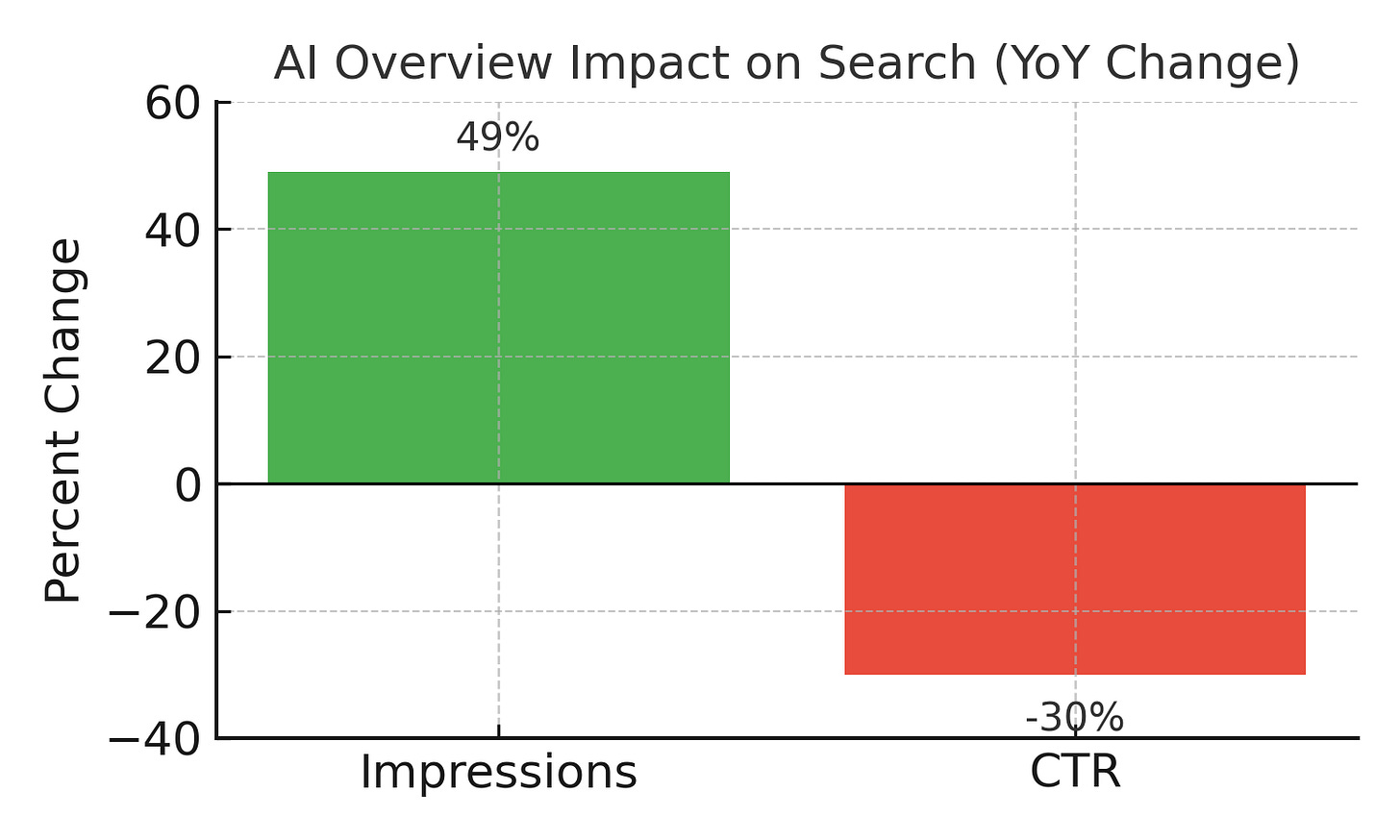
Put simply: your pages may be seen more often, but clicked less frequently.
Click Behavior Is Changing Fast
Pew Research’s July 2025 study confirmed the pattern: when an AI Overview appears, users click a traditional organic result just 8% of the time. Without the overview, that rate nearly doubles to 15%. And only about 1% of users click a link from inside the AI summary itself.
The summary often answers the query well enough that users stop there.
Google’s Spam Policies Are Being Enforced
In parallel, Google’s March 2024 core update introduced three important enforcement areas:
Scaled content abuse targets mass-produced pages, regardless of whether a human or AI wrote them, designed purely to game rankings.
Expired domain abuse penalizes sites using legacy domains to publish unrelated or low-value content.
Site reputation abuse cracks down on hosted third-party content that exists only to benefit from domain authority.
Each is now live and subject to both algorithmic filtering and manual penalties.
Zero-Click Is the New Baseline
SparkToro’s 2024 data showed that for every 1,000 searches in the U.S., only 360 led to a click on a third-party website. In the EU, that number was slightly higher at 374.
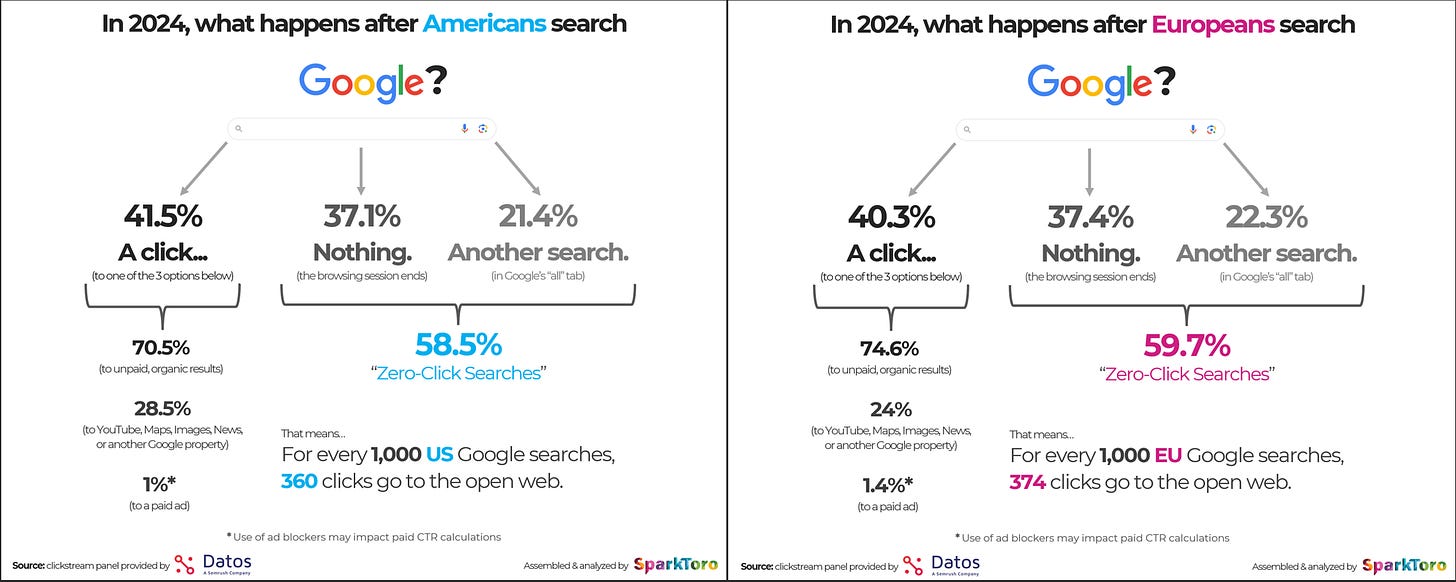
The majority of searches now end without a click, either because users find what they need directly on the results page and AI summaries, or because they abandon the journey entirely.
This is where things stand. AI Overviews have evolved from an experiment to the new default for complex queries, and they’re shrinking the window of opportunity to earn a visit.
Success now means adapting not just to rank, but to be cited, surfaced, and selected.
2. What Success Looks Like for a Founder
SEO is full of vague wins. “Ranking went up.” “Traffic looks healthy.”
But if you're a founder with actual revenue and customer acquisition targets, impressions mean nothing unless they compound into leads, trials, or signups.
Here’s what real SEO success looks like in 2025, measured by outcomes your team can track, own, and act on.
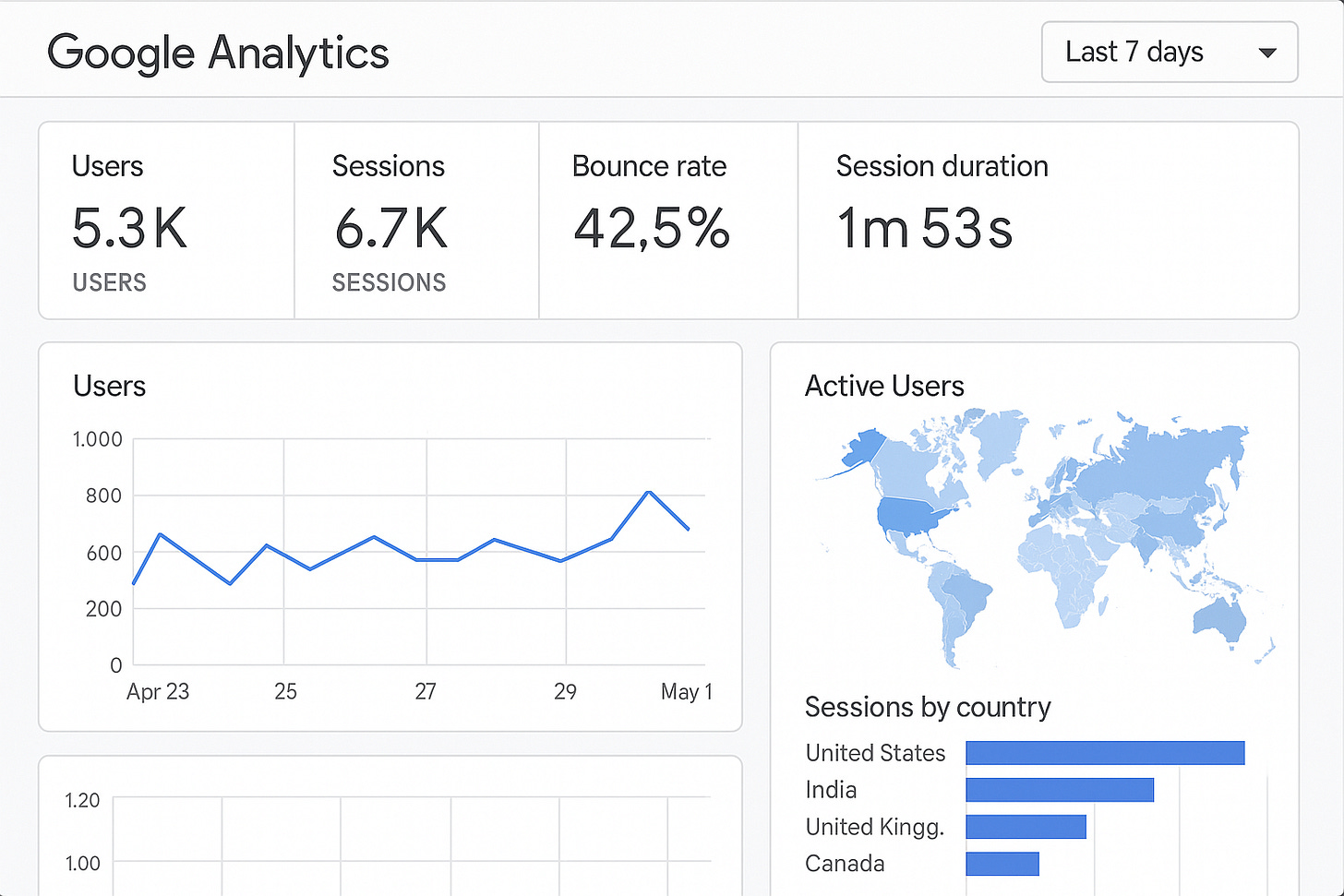
Your Pages Are Indexed, and Can Be Found
Crawl coverage isn’t glamorous, but it’s foundational. If your high-intent pages aren’t indexed or discoverable within 1–2 clicks from the homepage, nothing else matters.
What to track:
The percentage of your “money pages” (the pages that convert visitors to sales) that are indexed.
Average number of internal links pointing to each.
These two numbers reveal whether Google can find your content, and whether your site is helping it do so.
You Show Up in the Right Query Clusters
Not all rankings are created equal. Showing up for your brand name or “what is X” queries won’t move revenue.
You want visibility in high-intent clusters such as buying, comparing, implementing, and troubleshooting.
What to track:
Share of impressions in the top 3 positions for each intent cluster. Use Search Console Bulk Export to segment queries by cluster, then monitor changes over time.
Visitors Actually Engage, and Convert
Traffic only matters if it drives meaningful action. For early-stage teams, this usually means trial signups, demo requests, or add-to-carts.
What to track:
Conversion rate by intent cluster. This requires a basic join between Google Search Console and your CRM or analytics tool. It tells you which queries actually lead to revenue instead of just pageviews.
You Own What the AI Can’t Summarize Away
In the age of AI Overviews, generic blog content gets flattened. What survives are pages with original assets such as datasets, calculators, teardown walkthroughs, product how-tos.
What to track:
Presence rate in AI summaries for your top 25 priority queries. Pick a short list, run manual checks biweekly, and log whether your brand or URLs are cited in the AI Overview. This doesn’t scale perfectly, but it reveals whether you’re being quoted or ghosted.
If you’re hitting all four of these, you’re doing a lot of things right. It means you’re building distribution leverage across organic results, AI citations, and user intent that aligns with revenue.
3. The Founder Advantage: Why Lean Teams Can Dominate
Most SEO advice assumes you’re running a 20-person content team. But the most visible companies in the AI-powered SERP aren’t the biggest; they’re the ones that publish with speed, specificity, and first-party proof.
That’s your edge as a founder-led team. You can build pages that AI actually wants to quote.
Be Quotable, Not Just Rankable
Traditional SEO rewarded volume and backlinks. Generative engines reward quotability. In early 2024, researchers tested a new tactic: they took existing content and added structure, source citations, and expert-edited facts. The result was a 40% increase in AI summary inclusion across generative search engines like Bing Chat, SGE, and Perplexity.
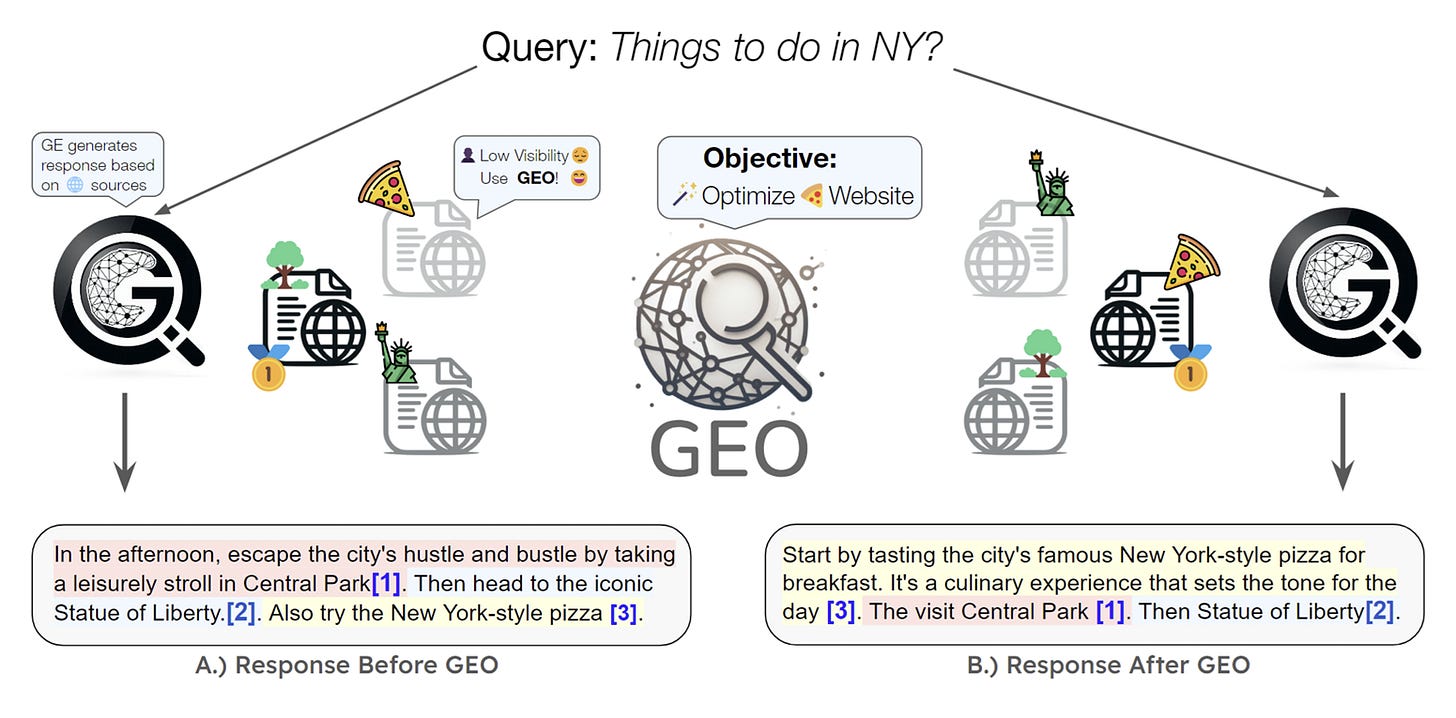
In this context, “visibility” doesn’t mean blue links. It means your sentence becomes the answer, surfaced inside the AI’s response. That kind of exposure can outperform even position #1 rankings, especially for niche queries where one quote can own the whole frame.
Why Founders Have the Edge
Proprietary artifacts: You have access to real screenshots, teardown workflows, and before/after benchmarks that generic agencies can’t fake.
Fast editorial loops: You don’t need six layers of review. You can ship in a day, update in an hour, and test again tomorrow.
Opinionated POVs: You’re allowed to say what others can’t. Honest takes. Sharp contrasts. Unfiltered lessons from your own product or ops.
The name of the game isn’t volume anymore. From now on, it’s signal density.
If a paragraph could live on a competitor’s site with a logo swap, it just doesn’t ship.
4. Start with Measurements You’ll Use (Set Up Once, Reuse Forever)
Before you optimize anything, get your data foundation right. The standard Search Console UI is fine for a quick look, but it caps queries, flattens pages, and hides long-tail patterns that matter.
If you’re serious about clustering, diagnostics, or attribution, you need full access.
Enable Bulk Export to BigQuery
Google now lets you stream your full Search Console data into BigQuery, daily. Setup takes 10 minutes and unlocks the visibility you actually need.
Here’s your baseline pull:
Timeframe: last 90 days
Columns: date, query, page, clicks, impressions, average position, country, device
With that exported, you’ll be able to sort by intent, isolate decaying pages, track AI summary exposure, and map clicks to outcomes, without relying on GA4 dashboards you don’t trust.
Group Queries by Jobs to Be Done
Forget keyword lists. Organize your queries by what the user is actually trying to do. Start with 6–10 buckets like:
Buy (e.g. “best CRM for remote teams”)
Compare (“Notion vs Coda for SOPs”)
Implement (“set up Slack automation with Zapier”)
Troubleshoot (“why is API call returning 403”)
Learn (“what is prompt injection”)
Migrate (“move Airtable base to Postgres”)
You can use embeddings or simple string rules to do this, no additional tools or coding required. What matters is that you connect each bucket to 1 Hub page that frames the problem, and 3–5 Spokes that solve specific angles of it.
This is how you move from a flat list of queries to a structured content system. And once it’s built, your reporting, prioritization, and refresh cadence get 10× easier.
Everything we cover next, including publishing, interlinking, building AI-proof moats, starts from this setup.
Do it once and reuse it forever.
5. A 30/60/90 Plan (Founder Timeboxed)
It may seem complicated at first, but you don’t need a 40-page strategy doc to dominate SEO. All you need is a sharp 90-day execution plan your team can run without a full-time SEO hire.
This one is designed for lean teams. It’s made for founders, product marketing managers, and growth leads who want results without chasing irrelevant metrics. Everything here maps to what matters: indexation, cluster visibility, pipeline movement, and resilience in the AI-dominated SERP.
Days 0–30: Fix What Blocks Google and Humans
Before you publish anything new, clean up what’s already hurting you.
Make key pages findable
Ensure your “money pages” (pricing, top-of-funnel, product how-tos) are no more than 3 clicks from the homepage. Scrap “orphan” pages, and add descriptive anchor text in your internal links.
Check for JavaScript rendering issues
If your primary content relies on JavaScript, ensure it’s rendered in a way Google can see, either via SSR (server-side rendering), SSG (static site generation), or hydration that doesn’t delay or hide the text.
If a user has to wait 3 seconds to read your first heading, Google might never index it.
Control bloat at the source
Google only fetches the first 15MB of HTML per page. That means your critical content and links should load early instead of being buried value below modals, footers, or third-party scripts.
Validate structured data, but don’t overpromise
Use JSON-LD where applicable (Article, FAQ, Product). Validate with Google’s Rich Results Test. But remember: schema doesn’t guarantee rich snippets or inclusion in AI summaries. It just makes your content easier to parse.
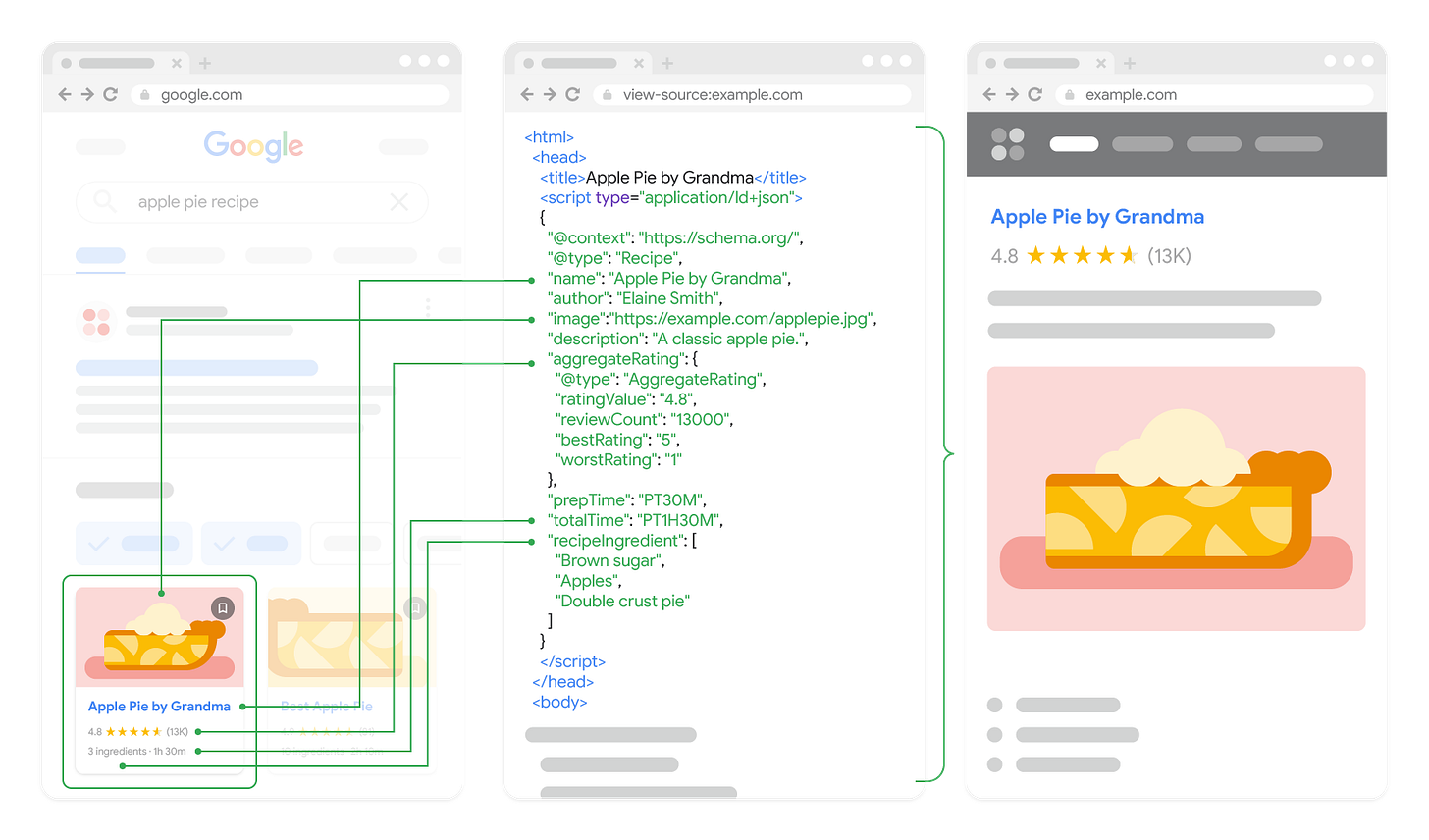
Days 31–60: Build the Content System
Once the plumbing’s fixed, it’s time to publish, but not at random.
Start with your top 2–3 intent clusters
Using your 90-day BigQuery export, group queries by “job to be done” (e.g. compare, buy, troubleshoot). For each cluster, publish 1 hub page that frames the topic, and 3–5 spoke pages with solutions, examples, or edge-case detail.
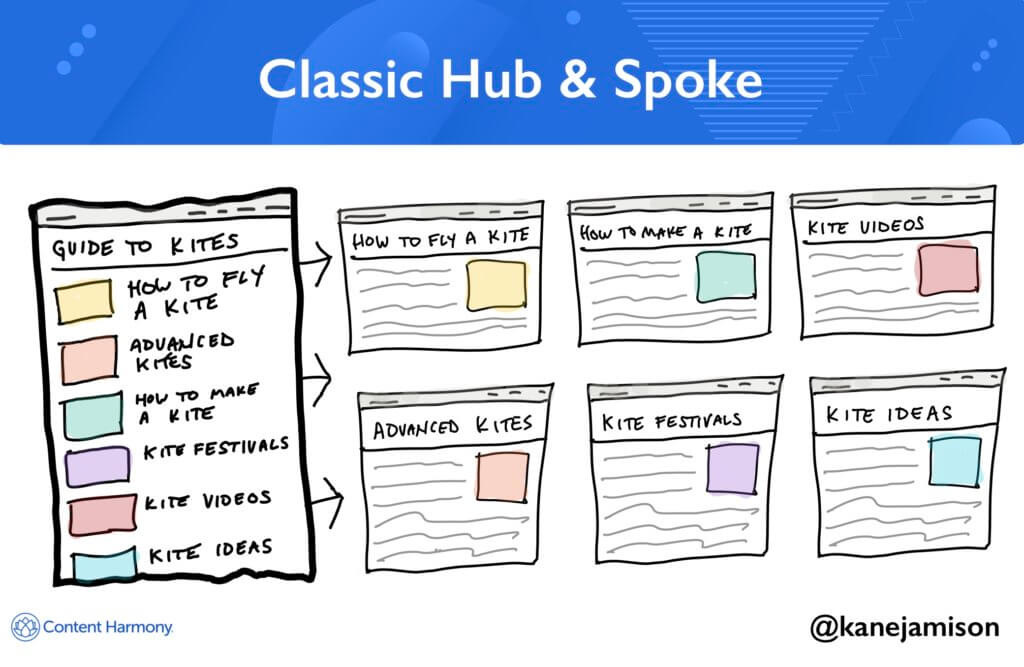
Every page should include a named author and “last updated” timestamp, at least one screenshot, chart, or config snippet, and internal links to and from related pages.
These elements are not just helpful for users. They also align with Google’s E-E-A-T principles - experience, expertise, authority, and trust. The “people-first” content guidance favors transparency and specificity.
If you’re publishing how-to pages, product explainers, or FAQs, add the appropriate structured data. Validate before pushing live.
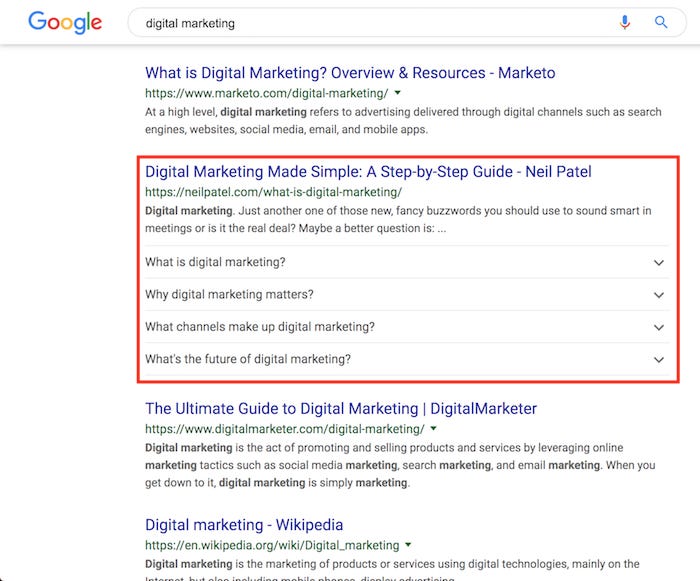
Lightweight internal linking beats broken silos
Don’t let important pages float alone. Add contextual links with descriptive anchor text (“compare CRMs for remote teams,” instead of “click here”). Avoid over-linking or keyword stuffing. Google is wise to it.
Days 61–90: Build Moats AI Can’t Summarize
This is where you start creating defensible assets that AI models struggle to flatten or replace.
Turn content into tools
Embed small calculators, live templates, teardown screenshots, before/after timelines. These are assets an AI can’t easily reproduce, and users actually interact with. Tie this directly to click-through rate (CTR) compression.
If you’re losing clicks to summaries, give people a reason to click anyway.
Use programmatic pages only when backed by real data
Directories, integration libraries, use-case generators; they work only if each page provides unique value. If your template just swaps names or inserts boilerplate, it’s a spam policy risk under site reputation abuse. Keep it lean. Scrap pages that don’t pull weight.
Create a refresh cadence, not a graveyard
Revisit your top-performing content on a quarterly basis. Prioritize pages that once drove conversions but now trigger AI summaries without attribution. Even a manual check (search your core query, see what the AI cites) can help you decide what to update next.
What Every Key Page Needs
Treat this like a build checklist for every money page, hub, or high-intent asset:
Open with a promise + time to outcome
“In 7 minutes, you’ll set up a live Zap between Notion and Slack.”Show, don’t assert
Use real screenshots, config snippets, datasets, teardown photos. Every major section should include one tangible artifact.Answer the buying questions
Who is this for? What does it cost? What could go wrong? What changes at scale?Compare explicitly, without affiliate fluff
Short tables are fine. Just be specific and honest. If your tool lacks a feature, say so. That earns trust, and citations.Guide to one next step
Include a single, obvious CTA to a product demo, live template, or calculator. Make it useful, not salesy.Support claims with sources
Cite Google docs, research papers, or verifiable benchmarks. Make it clear what’s an opinion and what’s backed by evidence.
Give this 90 days. If your foundation is solid and your content’s built to be quoted, you’ll see the difference. It will be notable in impressions, in AI visibility, and eventually, in pipeline.
Analytics You Should Care About
You don’t need another dashboard. You need a few sharp metrics that connect content to outcomes, and a routine for acting on them.
Here’s how to keep your SEO system honest and useful.
From Bulk Export: Start with Clarity
Once you’ve set up Search Console Bulk Export to BigQuery, run a monthly snapshot with two clear goals:
Compare performance by intent cluster
Pull impressions and CTR for each of your top 5–6 intent clusters (buy, compare, troubleshoot, etc.), and benchmark them against your sitewide average. This reveals where you’re visible and earning attention, and where you’re just ranking without traction.Identify the URLs that move pipeline
Join your export with CRM or analytics data to isolate the Top 10 URLs by assisted conversions. These are the pages driving trial starts, demo requests, or contact form fills, even if they aren’t your traffic leaders. They deserve protection, investment, and refresh priority.
Manual Check: Are You in the AI Summary or Not?
For your top 25 priority queries, run a quick monthly check:
Does the query trigger an AI Overview?
Is your brand, product, or page cited in that overview?
What’s the CTR when you are cited vs. when you’re not?
Even a spreadsheet with “yes/no” columns and CTR deltas tells you whether you’re in the conversation or being skipped. External data suggests CTR can drop by nearly half when AI summaries appear. Your numbers may differ, but they’re worth tracking.
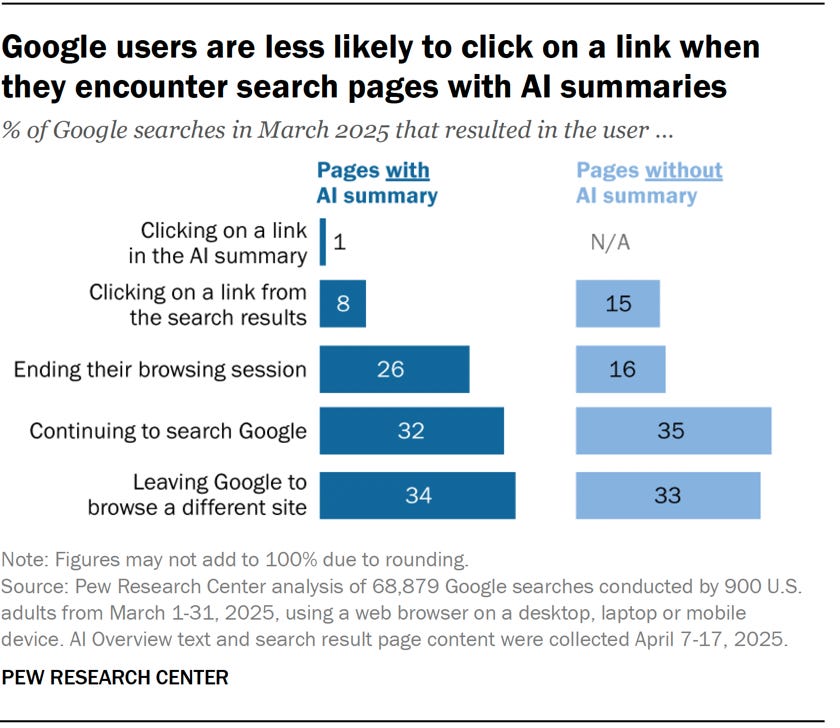
Decide, Then Act
Each month, choose just three pages to refresh:
One quick win (small update, fast boost)
One hub page (visibility anchor)
One money page (drives pipeline or gets flattened by AI)
That’s it. No “content ops backlog” or Monday standup debates. Just focused iteration based on what’s working, and what isn’t.
Set your calendar, run the numbers, and refresh with intent. Then let the rest of your content sit until it proves it deserves attention.
6. When (and When Not) to Use AI in Your SEO Workflow
AI can help you move faster. But it can also get your site flagged under Google’s spam policies if you use it the wrong way. The trick is knowing where AI creates leverage, and where it creates liabilities.
Where AI Actually Helps
Use a general-purpose LLM (no brand dependency) for specific, bounded tasks that reduce grunt work and accelerate decision-making:
Query grouping into intent clusters
Feed your raw Search Console export and ask the model to sort queries by user intent - buy, compare, troubleshoot, etc. This helps shape your hubs and spokes quickly.Content brief or outline drafting
Drop a cluster label (e.g., “compare Notion vs Coda for remote SOPs”) and ask for a proposed outline, including tables, visuals, and questions to answer. You’ll still write the piece yourself, but with a faster starting point.Internal link suggestions
Paste a page summary and ask for anchor text + link recommendations based on your site’s structure or query themes.Server log summaries
Feed raw logs or error reports and have AI surface patterns, like clusters of 4xxs, recurring redirects, or wasted query parameters.
These tasks are low-risk and high-impact. You stay in control. AI just does the sorting and structuring faster than you could with filters alone.
Where AI Becomes a Liability
Avoid using AI for anything that outsources authority, experience, or originality, especially when it touches your live domain.
No publishing unedited AI text
Whether you use AI to write FAQs, product comparisons, or how-tos, don’t hit publish without heavy editing. Google's scaled content abuse policy explicitly targets mass-produced, low-value content, regardless of whether a human or AI wrote it.
No fake “experience”
Don’t inject made-up user quotes, synthetic product walkthroughs, or generic “here’s what we did” fluff. Google’s E-E-A-T model rewards real expertise. Fake signals can get filtered, or flagged.
No third-party filler content
Hosting AI-generated guest posts, partner pages, or affiliate content just to rank is risky. Google’s site reputation abuse rule penalizes this exact tactic, even if you didn’t write the content yourself.
If your AI usage feels like a shortcut that saves time but sacrifices truth, it’s probably putting your rankings at risk.
Three Copy-Paste Prompts That Actually Help
Here are safe, job-relevant ways to put AI to work:
Prompt #1: Group queries into intent clusters
“Group the following 100 search queries into 6–8 clusters based on user intent (e.g., buy, compare, implement, troubleshoot, learn, migrate). For each cluster, give a name and 1–2 example queries.”
Prompt #2: Draft a content brief with assets
“Create a content outline for the topic: ‘best free CRM tools for small teams’. Include proposed H2s, one visual/table idea, and the core questions a user would want answered.”
Prompt #3: Suggest internal links
“Based on this page summary, suggest 5 relevant internal links with descriptive anchor text. Link suggestions should connect to related use cases, supporting guides, or product pages.”
Treat AI like a junior researcher and not as a ghostwriter. It can help you get organized, surface structure, and move faster. But the voice, experience, and proof still has to come from you.
7. The One-Page Checklist (End on Action)
Print it, paste it, share it in Slack. This is your tactical punch list for founder-led SEO in the AI era; no fluff, just the moves that work.
Enable Search Console Bulk Export → BigQuery.
Pull the last 90 days: date, query, page, clicks, impressions, position, country, device.Define 6–10 intent clusters.
Use embeddings or manual grouping. Publish 1 hub + 3 spokes for the top two clusters.Add author/date/proof to every key page.
Reinforces trust and aligns with Google’s “people-first” guidance. Screenshots, data, or config snippets per section.Add ≥5 descriptive internal links per money page.
No “click here.” Anchor text should reflect the target page. Fix orphan pages.Validate structured data.
JSON-LD format. Only use schema types that match the page’s true purpose, don’t stuff.Track monthly: CTR + conversions by cluster.
Use assisted conversion joins. Spot-check top 25 queries for AI summary presence. Refresh where summaries show.
This is founder-led SEO that compounds; one smart page at a time.
8. Play Offense, Not Defense
This is not a doom scenario. AI isn’t killing SEO. But, it’s changing the rules.
Founders who adapt by measuring what matters, publishing with proof, and building real moats will still win organic demand.
Ultimately, you don’t need a content army. You need a system. Start with the checklist, and ship one cluster this week.
Read more from Founders Corner:
CEO-Level Strategies for Confident Negotiation
How to Delegate Like a Founder CEO
Co-Founder Conflict 101: Should You Stay Together or Part Ways?



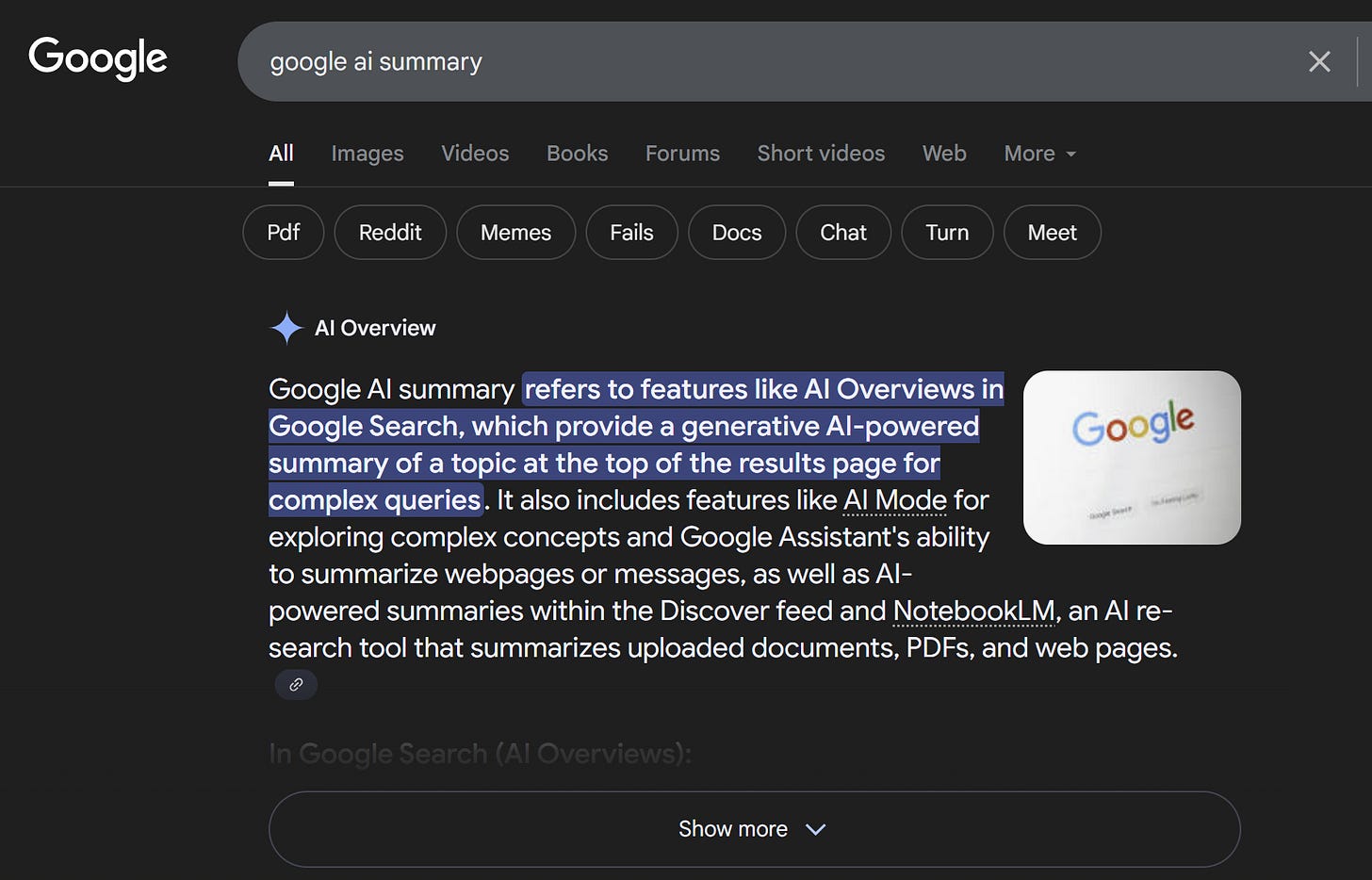

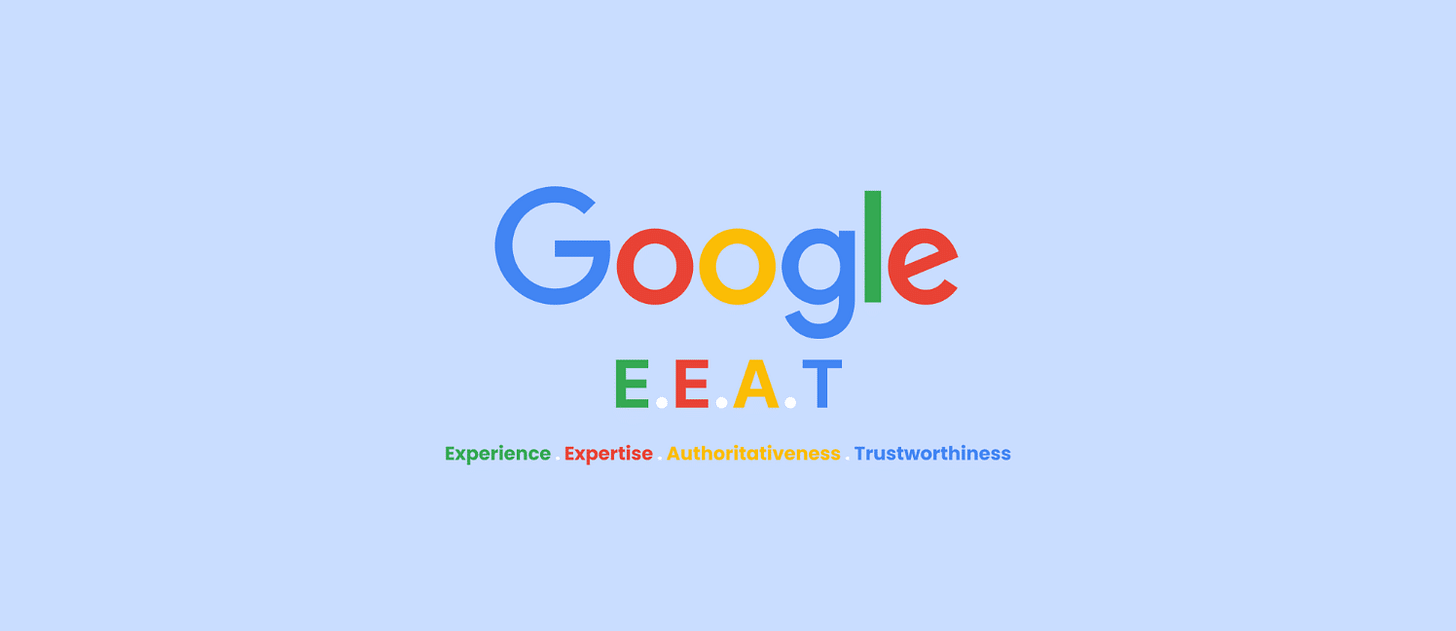
Very save worthy. Thank you for sharing, will do a deep dive! I have a project that could use this.
An interesting 🧐 read, you’re quite knowledgeable on some areas but miss on the one critical area that really matters, but don’t worry, all users do.
This founder who published 4 blogs per week for 6 months, fingers crossed after indexing, how long did it take to start seeing results in Google per page, typically?
Indexing = took …….. !
Visible ranking = took ……. !
This is the one critical factor ⤴️
The founder wasted all that time experimenting because they do not know that "Less is More" when it comes faster ranking.
What you need to know about SEO.
Today in general, SEOs are generally classed as lazy when optimising so fast SEO is not possible for them, they are not my words but taken from a top SEO on one of his youtube channels.
The Think Smarter Narrative to Win Faster, Optimise like a "CEO would think".
Less pages, keep to using SEO don’t jump ship to GEO/AIO/LLMs, knowing when to stop optimising but continue adding useful engaging content for users search queries.
What else: indexing and seeing visible results takes the same amount of time to see results in Google & it doesn’t take so long as Google’s AI keeps showing search queries. Remove empty SEO signals like your anchor text placement as they hinder progress. Think CEO.
Long-term growth comes from SEO but do SEO better than you think you know will deliver faster results.